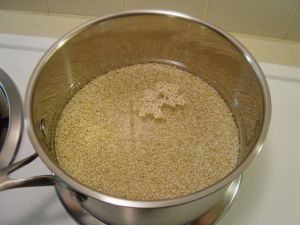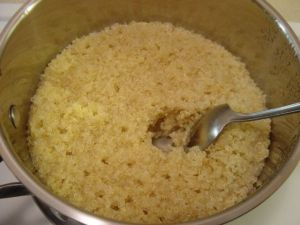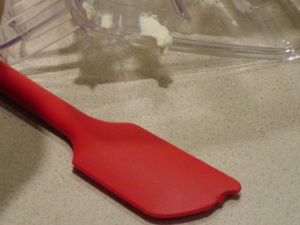Quinoa (kee-nwa) was an ancient food of the Incas – it was considered sacred and referred to as ‘mother of all grains’. Although no longer widely known or used it is gaining in popularity due to its nutritional qualities and versatility.
Unlike most other grains and seeds quinoa contains all of the amino acids needed for humans to assimilate as a high-value protein. In addition to being gluten-free and easy to digest it is a good source of dietary fiber, protein, phosphorus, magnesium and iron.
The quinoa seeds, as harvested, have a somewhat soapy and slightly bitter coating of saponins that discourage birds from consuming the seeds. Most quinoa available at your local grocers has been pre-soaked and rinsed to remove this coating. I always soak and rinse my quinoa whether it is presented in bulk or packaged and labeled as pre-rinsed. This insures that the seeds are clean, tender, and ready to accept the seasonings in your recipes be they sweet or savory. Evidently a short-lived experiment in raising quinoa without the saponins coating resulted in birds consuming most of the harvest. And so I soak . . . .
1) Measure out the quinoa and add enough water so that the mixture is slushy when stirred.
2) Pour the slush into a mesh strainer and thoroughly rinse. If the soaking water is only slightly hazy when stirring then 15-20 minutes is probably enough. These pictures are of bulk quinoa that needed about an hour of soaking and a change of water to clear.
3) Dump the soaked quinoa into your pan and cover with water. Turn the heat on medium until the mixture starts to bubble. Then turn the heat down low and put on the lid. Watch it very carefully until it settles down to a steady simmer because like oatmeal or pasta it will make fierce bubbles that climb the pot walls and boil over onto the stove.
4) The quinoa is done when it looks something like a sand dune on top with minor dips and valleys that are no longer moving. There should be no liquid visible when you take a spoon and check the bottom of the pot.
Cooking quinoa is similar to cooking pasta in that you may prefer it very tender or ‘al dente’. You may pre-cook it for a recipe or add it directly to liquids in the recipe. It has the capacity to absorb an amazing amount of flavor from added ingredients. I pre-cook it over low heat for 15-45 minutes; then turn off the heat and let it cool slowly on the burner. The longer it was soaked the shorter the cooking time. Also, if there is still water and it is cooked as long as you like then just drain of the excess water. If you cook it without salt or seasoning then you can use a portion of it in a sweet recipe and the remainder in a savory dish like this one.
This basic recipe was served at a potluck lunch meeting and received very favorable comments. It was prepared with a large, sweet onion and two fresh tomatoes. I included some ground turkey breast to make it a main dish meal.
When I make it for Rita, who is currently avoiding nightshade plants I use washed and chopped zucchini in place of the tomatoes. The resulting texture is very similar. I also add a small carrot cut in bits to provide some color,
Savory Quinoa Casserole
Ingredients:
1 cup of dry quinoa cooked with 2 total cups of liquid = 2-2.5 cups cooked quinoa
(If a can of organic diced tomatoes is used for part of the liquid then omit the fresh, sliced tomatoes.)
3 tablespoons olive oil
1 teaspoon ground yellow mustard (French’s yellow mustard works – it is gluten-free)
3 bay leaves
1 teaspoon ground cumin
1 large onion, chopped
1/2 teaspoon ground ginger
2 small tomatoes, thinly sliced (optional, see above, or zucchini))
1/4 teaspoon turmeric
1 teaspoon sea salt
2 tablespoons fresh cilantro
Directions:
Heat the oil on medium or medium high in a large skillet that has a lid. Add your mustard and bay leaf to the oil and let it sizzle. Stir while adding your cumin and wait a few seconds before adding the onion.
Sauté the onion until it starts to soften and turn brown. Add ginger, tomatoes (or zucchini/carrot), and turmeric. Let soften and then add your quinoa, stirring it in gently and sprinkling with salt. Reduce heat and cover, cooking for 8-10 minutes. Remove from heat, stir once, sprinkle with cilantro, cover, and let sit for 5 minutes. Fluff and serve.
If you add meat, tofu, or beans then include it already prepared along with the quinoa. This is a good recipe to extend leftovers from another meal. And any local vegetables in season are excellent options.
Gretchen (Mom) and Rita






